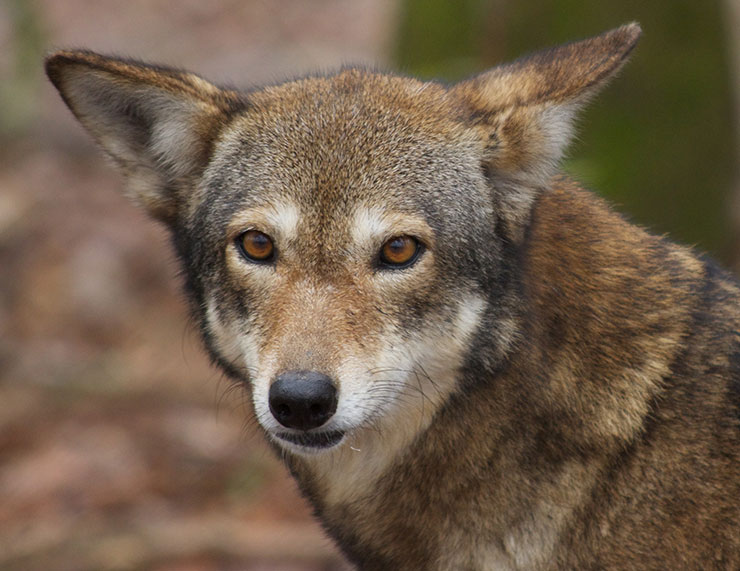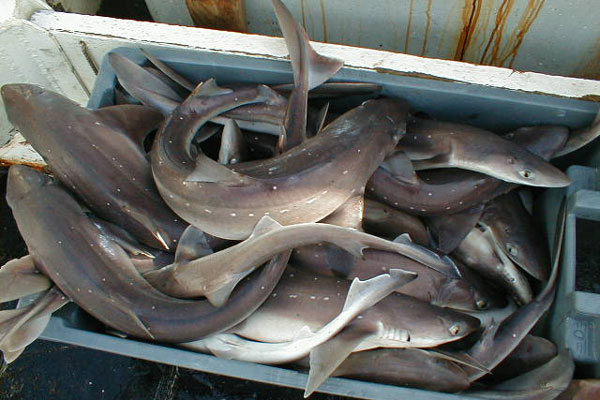NATURALIST’S NOTEBOOK: Return of the Red Wolf

This article was published in the Summer 2010 issue of Coastwatch.
The dense, humid air of a Dare County summer night is filled with anticipation. A large group of tourists walk quietly through the pocosin wetland of Alligator River National Wildlife Refuge. Their guide, Kim Wheeler, stops. She lifts her head toward the sky and lets out a garbled screeching noise — the best red wolf howl she can muster.
They wait.
“We never know if the wolves will howl back,” Wheeler explains. The animal’s unique voice is loud and shrill — more like a shriek than a bellow. This arresting howl allows communication among the more than 100 wolves spread throughout 1.7 million acres of the Albemarle Peninsula.
As the Red Wolf Coalition‘s director, Wheeler conducts these “howling safaris” beginning in April and ending in fall. Armed with flashlights, bug repellent and a desire to learn about the critically endangered species, participants creep through the refuge in the dark, hoping to catch sight or sound of a red wolf.
ON THE BRINK
Historical records reveal that the red wolfs range once spanned the eastern and southeastern United States, according to the U.S. Fish & Wildlife Service (USFWS). Animals could be found as far west as Texas and Missouri and as far north as the Ohio River Valley. At least one fossil record has been found in North Carolina.
Early European settlers sought to tame the land that makes up the present-day eastern United States. Red wolves, which often were portrayed as evil in folklore, were hunted and killed in great numbers. At the same time, people were building towns and cities in areas that were home to wolf populations.
“Trying to trap them was as natural as raising cows and chickens and going fishing,” says DeLene Beeland, a science writer tracing research for a book on red wolves.
That trend continued through several centuries, and red wolf populations declined as they were slowly pushed south and westward.
By the 1970s, the wild population had been reduced to a small area of marsh and prairie along the southern portion of the Texas/Louisiana border.
USFWS biologists decided to take action and save red wolves from extinction. All the wolves that could be trapped were removed from the wild by 1980, but hybridization with coyotes had reduced the numbers of pureblooded red wolves to a mere 17 individuals.
Captive breeding facilities were established throughout the nation to preserve genetic diversity and increase population numbers. Now with 42 locations nationwide, including five in North Carolina, the captive breeding portion of the program remains an essential piece of the red wolf recovery puzzle.
After success stabilizing the wolves in captivity, Alligator River National Wildlife Refuge in Dare and Hyde Counties was selected as the new home for a wild population of red wolves in 1987. Water protected them on three sides. Few humans were nearby. Prey was plentiful.
“I was there when the first group of red wolves was introduced — and they’ve become a part of Dare County’s history,” recalls Terri Kirby Hathaway, North Carolina Sea Grant’s marine education specialist.
LANDOWNER CONCERNS
Even though it had been more than 50 years since red wolves roamed North Carolina, human perceptions about them hadn’t changed much.
Obtaining local support for red wolf conservation was difficult because a meat-eating canid had never been reintroduced into its natural range. Despite landowners’ concerns, USFWS reports very few records of red wolves preying on livestock or pets.
Aaron Jenkins of Duke University’s Nicholas Institute for Environmental Policy Solutions co-authored a study focusing on the economics of red wolf conservation. In his study, he surveyed farmers from the counties where red wolves are newfound — Beaufort, Dare, Hyde, Tyrrell and Washington — as well as one adjacent county, Bertie.
The survey tested farm operators’ willingness to participate in a program offering compensation for landowners who used their private land to improve natural habitats and promote public conservation efforts.
Overall, roughly half of those surveyed said they would be interested in a general payment program, with conservation being their main motivation. But that number dropped to 20 percent when red wolves were named as the target species for conservation.
“People in this area seem to be pro-wildlife,” Jenkins says. ‘Yet there is strong dislike for wolves,” he adds.
Those surveyed cited reasons including poor usage of tax revenue and unnecessary infringement on private land.
According to Jenkins, many of these concerns aren’t exclusive to red wolves — the objections extend to any other conservation effort as well. Thus, Jenkins notes, the concerns don’t explain the large disparity between limited red wolf conservation support and greater general wildlife conservation support.
ALLIGATOR RIVER TODAY
Despite some resistance, the red wolf recovery effort is a success on many fronts, according to David Rabon, coordinator of the Red Wolf Recovery Program at USFWS. Growth has been stable, if slow, for North Carolina’s red wolves. Today, there are 110 to 120 wolves in the total wild population.
“The initial obstacle was the fact that the wolves had been raised exclusively in captivity,” Rabon explains. ‘There were no wild wolves. The wolves had to learn to be wolves again, to be wild again.”
Another obstacle came in the form of coyotes. During the 1990s, coyotes began spreading into Eastern North Carolina and mating with red wolves. By the end of the decade, hybridization with coyotes became the greatest issue facing red wolf recovery.
Because red wolf packs feature a single, monogamous breeding pair, scientists couldn’t remove a coyote once it was established as a red wolfs mate. Rather, USFWS began sterilizing coyotes. Although this intervention limits the number of potential wolf offspring, it protects the species integrity of red wolves.
Despite such challenges, the project is a win, Rabon notes.
“We are seeing that we do have the ability to restore a large predator to its natural habitat.”
ECOLOGICAL AND SOCIAL BENEFITS
In recent years, challenges such as natural competition from coyotes have slowed the red wolfs population growth. Yet, according to Rabon, the biological, social, economic, and educational benefits of the recovery program are significant.
Being the first successful canid reintroduction, the Red Wolf Recovery Program now serves as a model for other conservation efforts around the nation — most notably the gray wolf reintroduction in Yellowstone National Park.
The red wolf has fulfilled its historic role within its natural range, creating a more diverse, stable ecosystem, according to USFWS officials.
Top predators help to keep their prey animals in check,” Wheeler says of the need for a balanced ecosystem.
When there are few predators, some animals will overbreed, leaving the population with more animals than the food supply can support. As a result, starvation and poor health become common.
In terms of education, Wheeler’s howling tours provide a unique, hands-on opportunity for eager residents and tourists to learn about the rare red wolf, as well as other local wildlife.
“On the way, one might see a black bear, deer or wild turkeys. Once at the howling site, it is my job to see if I can get the wolves to howl,” she says.
Sea Grant’s Terri Kirby Hathaway chose the red wolf to be among the 100 examples of flora, fauna and special places that will be featured in the forthcoming North Carolina’s Amazing Coast book. “The red wolf recovery here is a unique success story,” she notes.
The wolves, and related tours, also can promote economic growth by way of eco-tourism. Angie Brady-Daniels of the Outer Banks Chamber of Commerce notes that eco-tourism is woven across the coastal economy, even if it may be difficult to pinpoint the number of people who visit the area for a specific tour or activity, such as the red wolf safari.
“We do realize that each of these attractions offers our guests something enjoyable to do that they will add to their itineraries,” she notes.
Wheeler agrees. “People are willing to pay to attend a program that teaches them about red wolf conservation. When they are visiting the area, they are shopping, eating and exploring the local communities.”
All of those activities add dollars to the local economy, she adds.
Some folks would say that is worth howling about.
Learn more about the Red Wolf Recovery Program online: www.fws.gov/redwolf.
Look up the 2010 howling safari schedule online: www.redwolves.com.
For contact information and reprint requests, visit ncseagrant.ncsu.edu/coastwatch/contact/.
- Categories:


